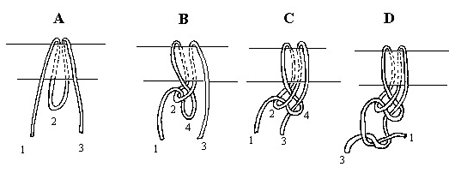< Back to Articles
Tying Viol Frets

Place the instrument securely on a table or other flat surface so that the neck extends toward your left.
Remove the old fret by clipping the knot with some fingernail clippers.
Tie the new fret down the fingerboard, (toward the nut). The fret will be pulled up into position when it is finished. This will help to hold the fret tightly on the neck.
Loop the fret material and slip it under the strings as in figure A. We will call this loop 2. The two ends should be sticking out from the strings toward you. We will call these strand 1 and strand 3. Loop 2 passes around the back of the neck and also faces you.
Make another loop in strand 1. We will call this loop 4.
Pass loop 4 through loop 2 as in figure B.
Now, pass strand 3 through loop 4 as in figure C. Pull the knot tight. Don't worry about getting it too tight. Just pull the gut and settle it so that there is no slack in the fret.
Now, make a simple over hand knot with strands 1 and 3 as in figure D. Pull this knot tight.
Clip the ends of the strands about 1/8 inch from the knot. Use a small flame or soldering iron to burn the ends up to the knot. Be careful not to burn the knot or the instrument!!
If you need to, rotate the fret on the neck so that the knot is more or less at the joint of the fingerboard and neck.
Pull the fret up the neck into position.
#
Hand-made in the USA by Gamut Music, Inc., a leader in the revival of early music strings and instruments. Gut strings are not intended to be used with fine tuners or string adjusters, and those devices should be removed before installing the gut string on the instrument.
All Gamut Academie strings (pure gut and gut/metal-wound) are made with beef serosa unless they specifically say "Sheep Gut." All pure gut Tricolore violin and viola strings are made with sheep gut; gut/metal-wound Tricolore and all Red Diamond strings are made with beef serosa.
Gamut gut string gauges are approximate (≈) diameter. Meaning, that while a ≈0.60mm string is polished in the workshop to a diameter of 0.60mm, changes in ambient humidity, temperature, shipping, and storage conditions can cause to string to expand or contract slightly.
Gimped gut strings and custom gauged equal tension strings are gauged with the equivalent-gauge (=) system. This means that the gauge listed, such as =1.50mm, indicates that the string is approximately equal in weight to a plain gut string of that diameter. Of course, because the wire is much heavier than gut, the string will be much thinner than a plain gut string.
More information about Gamut gut strings, string types, gauges, and string tensions can be found on our FAQ/Articles page. Not finding an answer to your question? Please contact us.
